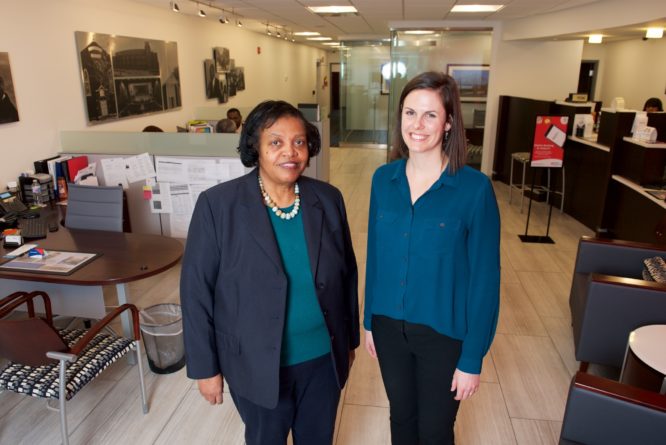It’s the summer of 2002. Fredica M., a St. Louis native who’s moved back to the Midwest after spending some time in California, is a 25-year old mother renting an apartment in South City. She’s glad to be back in her hometown, and expecting her third child.
What she isn’t expecting is becoming homeless.
When the building Fredica lived in on Morgan Ford Road was condemned for basement flooding and a mouse infestation, she suddenly found herself and her children – then ages 5 and 1 – without a place to stay, or the means to secure a new home.
She sought help at Our Lady’s Inn, where she remained for six months. The shelter provided Fredica with a connection to housing, helping her get on the list for Section 8 through St. Patrick Center. With that program, “You earned money for your deposit,” she explains, “and went to different classes.” The Center’s list of landlords who rented to Section 8 voucher holders was also a valuable resource that enabled her to move out of the shelter and into her own apartment.
Over the years, Fredica has lived in several different places, mostly around South City. That’s largely because her family has grown: she has five school-aged kids, 5 to 18 years old. And today, she’s in the midst of seeking a place big enough for them all, a number that now includes the infant of her eldest daughter, who is working for MERS Goodwill and goes to Gateway STEM High School.
Being a Section 8 voucher recipient theoretically shouldn’t make finding a home more difficult than it would be for a non-subsidy user, especially in the part of STL where Fredica currently lives and hopes to stay. Just this year, St. Louis City passed two bills designed to encourage landlords’ Section 8 program participation and prohibit rejection of prospective tenants on the basis of voucher use. But these measures haven’t necessarily translated into better access, particularly given the persistence of negative perceptions about housing voucher users.
Fredica’s been told as much by several landlords. “I guess some people on Section 8 destroyed properties,” she says, and that “makes it hard for me to find something within the city because landlords don’t want to keep putting money into property that’s going to be destroyed.”
Wanting to find “a decent place that’s not outdated in a good neighborhood” is just one part of the challenge, however. The other part, says Fredica, “is coming up with a larger deposit for a bigger place will be $1,000,” on top of which there’s the standard credit and background check that can cost up to $75. And because her oldest child is 18 (and still a high school student), Fredica – who’s been on unemployment since sustaining injuries in a car accident last November – must pay for two such checks for every application she submits. That’ll be tough without the income she made with her past work in daycare/early childhood education, which she hopes to resume when she’s well but can’t handle just yet.
Fredica relies on her faith in God and love for her family to stay optimistic about finding the next place to lay her head. Finding the three-bedroom apartment she’s living in now “took a long time,” she says, because “a lot of the places that [took] Section 8 were in bad neighborhoods” with “visible trash on the street… grass not cut… alleys not taken care of…”. So the challenge isn’t new to her.
As she continues her search for a bigger place, which she’ll need to move into by November 21* but is “coming right on time,” Fredica occasionally dreams about what she’d like to have when she meets “her goal to get off Section 8.” Things like central air, a laundry room with washer and dryer; a double-sink kitchen with an island, and a living room and a dining room. A fenced-in backyard with nice grass, and concrete; and a driveway where she can park a car.
Mostly, though, her mind, as well as her time, spent poring over websites and other leads to rentals in South City, is focused on getting what’s most important:
“Someplace clean and safe for my kids. A diverse neighborhood where I see kids playing. People not going into their houses through their back doors so you only see new neighbors when they first move in. A sense of community and love and concern for one another.”
In that sense, Fredica’s search is no different from what so many others in the St. Louis region want when they’re looking for a new family home. It’s also the details of her situation that make her case all too familiar to some and many worlds away to others.
*Update: Fredica and her family will move in mid-December. She has found a house in South City managed by “a great landlord” whose low move-in fee, relative to others’, is meant to help “develop a good relationship with her tenants.”
“I’m so grateful,” Fredica says.
Written by Elaine Cha for #FwdThruFerguson
Photo by Lindy Drew




